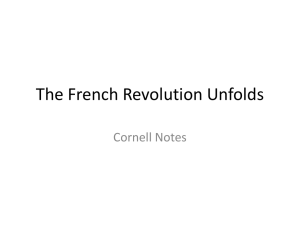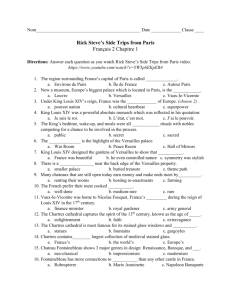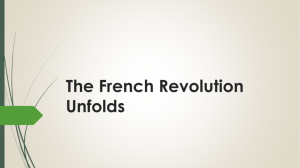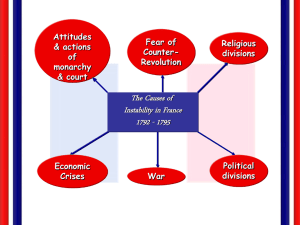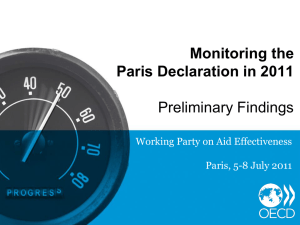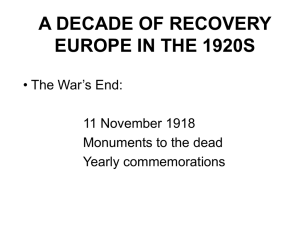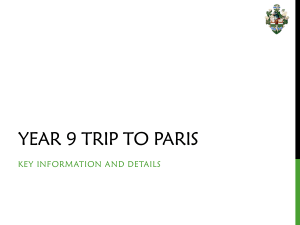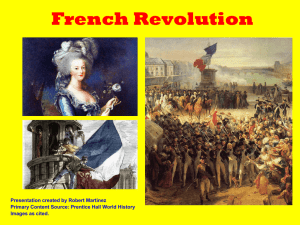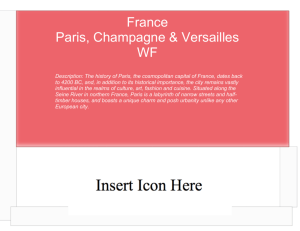Creating A New France
advertisement
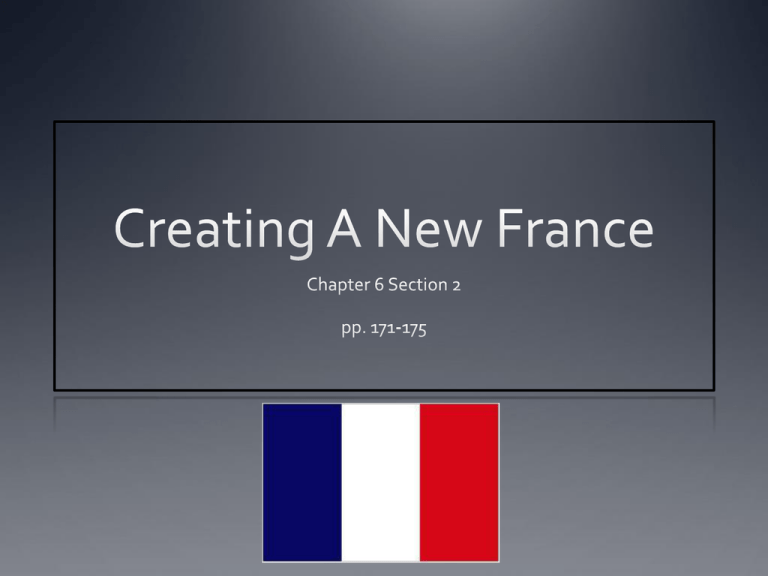
Vocab Faction-small groups Émigré-person who flees his or her country for political reasons Republic-government ruled not by a monarch Revolts in Paris and the Provinces The political crisis of 1789 coincided with the worst famine ever Peasants roamed the country or flocked the town As grain prices soared, everyone had to spend up to 80% of their income on bread The Great Fear Rumors ran wild and set off what was later called the “Great Fear” Tales of attacks on villages and towns spread panic Because of the famine and fear, peasants unleashed their fury on nobles who were trying to reimpose medieval dues Attacked noble’s homes, set fire to old manor records, and stole grain from storehouses Paris in Arms As the capital and chief city of France, it was Paris was the revolutionary center A variety of factions competed to gain power Moderates looked to the Marquis de Lafayette- the aristocratic hero who fought alongside George Washington A more radical group called the Paris Commune, replaced the royalist government of the city Some demanded an end to the monarchy and spread scandalous stories about the royal family and court members The Guard was the first group to don the tricolor- a red, white, and blue badge which eventually became the flag of France Moderate Reforms Peasant uprisings and the storming of the Bastille stampeded the National Assembly into action On August 4, nobles in the National Assembly voted to end their privileges Gave up their old manorial dues, exclusive hunting rights, legal statues, and exemption from taxes An End to Special Privilege Delegates abolished feudalism at 2 a.m. on August 4 The National Assembly turned the reforms of August 4 into law,. meeting a key Enlightenment goal– the equality of all citizens before the law Declaration of the Rights of Man In the late August, the Assembly issued the Declaration of the Rights of Man & the Citizen The Declaration proclaimed that the all male citizens were equal before law The Declaration asserted freedom of religion and called for taxes to be levied according to ability to pay They followed the French Revolution slogan “Liberty, Equality, Fraternity.” Women March on Versailles On October 5, thousands of women streamed down the road that led from Paris to Versailles They were angry at the queen, Marie Antoinette The women refused to leave Versailles until the king met their most important demand– to return to Paris He agreed but wasn’t happy about it The National Assembly Presses Onward The National Assembly soon followed the king to Paris To pay off the huge government debt, the Assembly voted to take over and sell Church lands Reorganizing the Church The National Assembly put the French Catholic Church under state control Under the Civil Constitution of the Clergy, bishops and priests became elected, salaried officials Many priests and bishops refused, as well as peasants A huge gulf opened between revolutionaries in Paris and the peasantry in the provinces Constitution of 1791 The Constitution of 1791 set up a limited monarchy in place of the absolute monarchy A new Legislative Assembly had the power to make laws, collect taxes, and decide on issues of war and peace Only about 50,000 out of 27 million men could qualify as candidates to run for Assembly The Constitution abolished the old provincial courts and it reformed laws Reflecting Enlightenment goals, it ended Church interference in government and ensured equality before the law for all male citizens Louis’s Failed Flight Marie Antoinette urged the king to escape their situation On June 1791, the king disguised as a peasant and the queen dressed as a governess rolled into Paris Their attempted escape failed A company of soldiers escorted the royal family back to Paris Widespread Fears European rulers increased border patrols to stop the spread of the “French plague” Those fears were horror stories told by emigres They reported attacks on their privileges, their property, and even their lives In Britain, Edmund Burke bitterly condemned revolutionaries in Paris. He predicted that the revolution would become more violent Threats From Abroad The failed escape of Louis XVI brought further hostile rumblings from abroad In August 1791, the king of Prussia and the emperor of Austria issued the Declaration of Pilnitz Stated that two monarchs threatened to intervene to protect the French monarch Revolutionaries in France took the threat seriously and prepared for war War at Home and Abroad In October 1791, the newly elected Legislative Assembly took office Faced with crises at home and abroad, it would survive for less than a year Uncertainty about prices led to hoarding and addition food shortages Internal Divisions In Paris, working-class men and women called sansculottes pushed the revolution into more radical action By 1791, many sans-culottes demanded a republic government Within the Legislative Assembly, several hostile factions competed for power Sans-culottes found support among radicals in the Legislative Assembly, especially the Jacobins War on Tyranny The radicals soon held the upper hand in the Legislative Assembly In April 1792, the war of words between French revolutionaries and European monarchs moved onto the battlefield The Legislative Assembly declared war first on Austria, then on Prussia, Britain and other states The fighting that began in 1792 lasted on and off until 1815 Review Tri Color-A red, white, and blue badge that became the flag of France Jacobins-a revolutionary political club that supported the sans-culottes Faction-small groups Émigré-nobles, clergy, and others who had fled France and its revolutionary forces Sans-Culottes-working class men and women who pushed the revolution into more radical action Review con’t Marie Antoinette-Queen of Versailles married to King Louis XVI Louis XVI-King of Versailles
